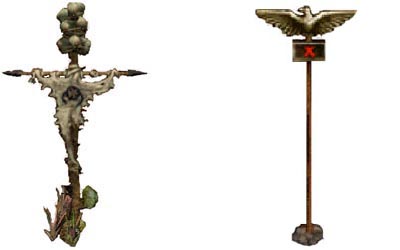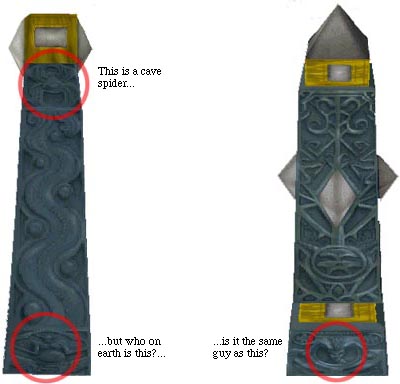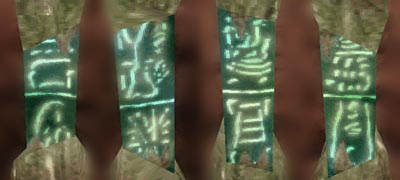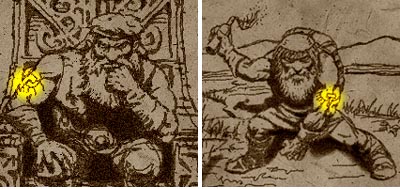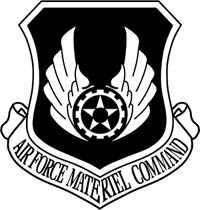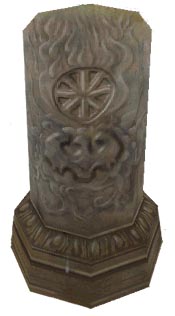Symbols
World Knots
Man from Nan points out that all the World Knots in Myth have different symbols.

Pools of Iron, Force Ten From Stoneheim, and Homecoming, respectively.
Mobius has come up with a plausible explanation for this:
I think it is rather similar to an idea in the "Riftwar Saga" by Raymond E. Feist. The magicians are capable of teleporting themselves from one location to another, provided that they can fix a certain, familiar and unique image in their head from that location. Thus those magicians take to placing intricate designs at certain locations to facilitate transporting there easier. So, when a magician wants to transport a group there, he must think of the image on the Knot pillars.I'd suspect that a knot map would have a copy of each knot's unique symbol next to the location on the map. That's how Alric would know there's a World Knot by Rhi'Anon and be able to take them there in the Last Battle.
That might explain their purpose, but still not their meaning.
Marker Stones
Seven of these cryptic stones mark Bagrada, and three Ground Zero. The Myth Mandrake Connection originally brought these to the community's attention.
Standards
Here are the Battle Standard found in Myth:
ThorulfR writes:
Legions are roman imperial combat units.
The standard displayed in Shadow on the mountain has an eagle on top of it. The romans used eagles as battle standards.
The standard shows a X, possibly the roman numeral 10.
If I am not mistaken the X (tenth) Legion was the best known unit of the best known roman ruler, Julius Caesar.
The Smiths of Muirthemne
These symbols and glyphs can be found in the two Tain levels of Myth TFL.
Mobius writes:
What else lives in the Tain besides Giant Spiders and Myrkridia, supposedly???
Sure- there was a pile of skulls found in the Tain, both Human and otherwise... but suppose that Connacht had to transport a certain number of "innocent" humans and other creatures in with the Myrks- like trapping an entire city's worth of individuals... Just as a number of Dark units were trapped in the Tain with the Light units by Soulblighter after the battle of Forest Heart (Though Pimpy makes an interesting poing- why were no Forest Giants tossed into the Tain with the other Light units?).
Mobius adds:
But look at the right pylon... just below that diamond-like projection. It, too, looks like a horned creature (see them protruding out to the sides of the pylon?). And the image at the very base of the right pylon is interesting, too.
He also points out a small similarity between the symbol above the horned beast on the right pylon, and the symbol on the Myrkridian battle standard. My thoughts are that the Lightning Towers were constructed during the imprisonment of the Myrkridia, when they and the spiders were the only dangerous beings imprisoned. The artists that made the towers were inspired by this and made the Myrkridian and Spider symbols. Pure conjecture mind you (but what isn't ;P). Also, what were the towers for? To defend from spider and Myrkridian attacks when the keepers of the Tain used it? (as the only spots that are protected by towers are the pearl gates).
Reid McDonald suggests that the runes on the glowing pillars in Heart of Stone may be escape instructions. They look like pillars in various states, bridges, and other such things found in the Tain.
Myrgard
Look at this Dwarven tatoo from the intro movie to Sons of Myrgard.
This may be the symbol for Myrgard, Dwarves in general, or perhaps this specific group of paratroopers
Dennis "Pigseye" Taylor notices the same dwarven tatoo in the victory screens for Sons of Myrgard and A Long Awaited Party.
Brian Landwehr and Sidral both offer similar explanations of the symbol's meaning. Brian writes:
The dwarven tattoo seems pretty straightforward to me. It's a hammer (one of the standard symbols of dwarves everywhere) with wings. Symbol of the dwarven paratrooper corps. Take a look at the paratroop symbols for the U.S. army -- a number of them are some device with wings.
...and Sidral backs that up with his comments:
The dwarven tattoo depicted repeatedly in the Myrgard stages may be a symbol for the dwarven city entire, but I think it's more specific than that. The hammer is a well-established symbol of dwarvenkind, alluding to their craftsmanship (and possibly their bloodthirstyness). The wings are the giveaway -- where do we first see the tattoo? On the arm of an impatient dwarven paratrooper. And with the exception of Balin, who are all the dwarves in both the Myrgard stages? You got it. No doubt the tattoo is the insignia of the courageous dwarven paratroops, and it makes sense that a group as seemingly exclusive as flying dwarves would have such an identifying mark. Wonder if they have a secret handshake, too?
The Dire Marsh
Denis.Man Of Zinc notes an interesting symbol carved into some pillars in The Watcher.
He theorizes:
The Dire Marsh isn't all that far from Rhi'anon. The Cailleach must have inhabited the Dire Marsh (and judging by the markings had a pretty formal empire).
I have no idea how he jumped to that conclusion.
James has a clearer picture of that symbol:
The pictures on the pillar in the Dire Marsh appear to depict a comet descending on a phoenix (a heron or the symbol of the empire of Cath Bruig?) ... Perhaps this is the birthplace of Balor and/or the outer frontier of the empire.

